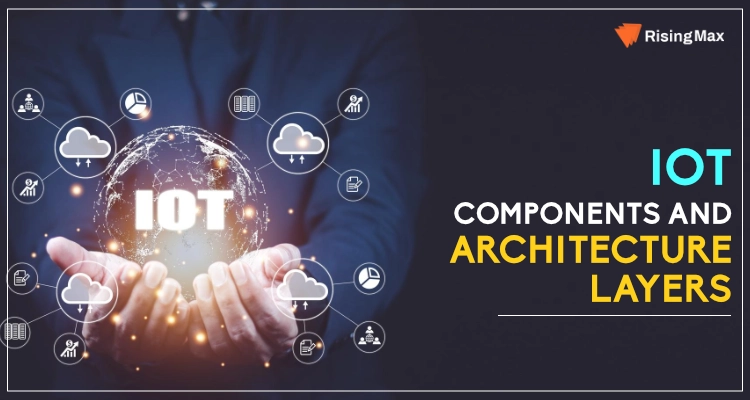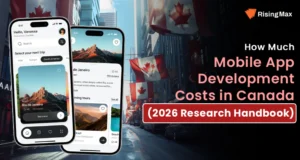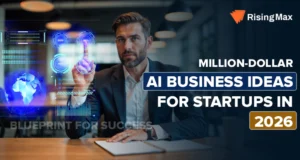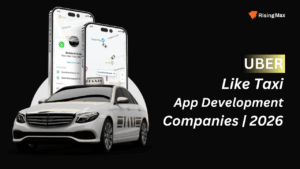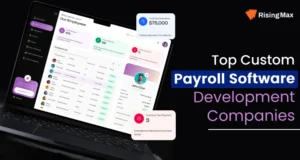The Internet of Things is one of the most trending technologies. That has brought a huge transformation in every industry. The IoT is a system that connects multiple devices.
Whether it is retail, manufacturing, healthcare, or education, the revolutionary IoT technology is being used in various industries. From helping doctors monitor their patients from remote locations to helping transport companies to monitor their business activities through IoT-based software, which can be easily accessed on mobile phones, IoT has transformed the way businesses function.
Are you planning to get an IoT-based app developed for your business? Well, our IoT experts at RisingMax Inc. can assist you with this. We use cutting-edge technologies and developed a user-centric IoT app for your business. Connect With Our Experts!
In this blog, we will discuss the 7 components of IoT, its architecture, and use cases in various industries.
Align the current state of IT with your business strategy by hiring the most trustworthy IoT development company
Basic Components Of The Internet Of Things
Do you want to understand IoT technology in a better way? Well, the technology has some basic components which help in successful functioning. Have a look at the below-mentioned 7 components of iot and better understand the functioning of an end-to-end IoT system:
Sensors And Actuators
The sensors are one of important components of iot. They collect various types of data from the outer world, such as temperature, humidity, distance, location, weather and climatic conditions, and other data types. They establish a connection between the real world and the digital world.
The sensory devices are of various types, such as meters, sensors, probes, gauges, actuators, proximity sensors, and RFID tags. On the basis of the information collected by the sensory devices, they perform various tasks, such as switching off the light, giving automatic weather updates, and providing location guidelines without the involvement of human interaction.
Connectivity
After the data is collected by the sensory device, it will be sent to the cloud for processing. For this, there must be connectivity through which data will travel further. There are a variety of mediums through which connectivity can be established.
These mediums include cellular, satellite, WiFi, Bluetooth, low-power wide-area networks, and other connectivity mediums. Any medium can be chosen depending on the type of data, bandwidth power consumption, and efficiency. Although all the above-stated mediums perform similar tasks, they differ from each other in terms of efficiency and processing speed.
Computing
After the data is sent to the cloud, the computing of data occurs. In this, the data is being processed in a usable form. During data computing, the size of the data is reduced. This is done to extract useful information from a large amount of data. On the basis of the data, important decisions related to the business are made.
Computing is an important component of IoT architecture. At this phase, tons of data are being processed and converted into the form businesses can use to accurately study ongoing trends and customer behavior. Proper computing helps to enhance the functioning of the IoT.
Also Read: IoT App Development Companies in USA
Cloud-Based Platforms
The Internet of Things devices use cloud storage for storing the data collected by them. The IoT cloud-based platforms provide tools that help users collect, process, manage and store huge amounts of data in real-time. These platforms are available on the internet 24/7 and can be accessed anytime from anywhere by businesses for making important business decisions.
The IoT cloud platforms are responsible for effectively managing, storing, and processing the data collected from the external environment. In simple words, IoT cloud platforms refer to the set of servers connected to the internet 24*7.
Analytics
After the successful processing and storage of data to the cloud platform, another important component of IoT is analytics. In this, the data is being processed to drive insights and valuable information from it. The analytics helps to present the data in an organized and brief manner. Various algorithms, such as machine learning and other techniques, are used to process the data.
This will make it more understandable and readable. The analytics of raw information into useful information is a prerequisite for monitoring and enhancement of IoT devices. The well-designed analytics are very important for businesses to make the right decision at the right time.
User Interface
The user interface is a tangible part of the IoT system. This component of the IoT architecture can be accessed by the users. While designing the user interface, the designers must ensure that it is smooth and easy to access.
This will help in minimizing human efforts and make their app browsing experience more enhanced. The user interface allows users to monitor and make changes in the data generated by the IoT sensors.
Security
The cloud-based platforms where data is stored have various features in them, such as end-to-end encryption and authentication and other features.
What Do You Mean by Internet Of Things (IoT) Architecture?
The IoT architecture is the way in which various IoT devices are structured in order to meet the basic needs of the users. The devices are arranged in various layers, and each layer plays a significant role in the overall functioning of the IoT system. They are differentiated with a motive to track the consistency of a system through protocols and gateways. The layers in an IoT architecture depend upon its complexity and user requirements.
The IoT architecture consists of numerous tangible and intangible elements, including sensors, protocols, actuators, cloud services, and other important elements.
Are you looking for a reliable IoT software development service provider?
Well, you are in the perfect place. RisingMax Inc. is well known for its futuristic and customized IoT software designed to help blockchain businesses explore the potential of the iot industry.
Internet Of Things (IoT) Architecture Layers
Well, you must have understood the basic 7 components of the Internet of Things and the meaning and function of IoT architecture. Now let us move further and understand the components of iot architecture and functions performed by each layer in the overall functioning of the IoT.
Perception Layer
The perception layer is the first and most important layer of an IoT architecture. This layer is also called the device layer. The layer has multiple elements in it, such as sensors, cameras, actuators, and other devices which perform the function of gathering data from the physical environment. The devices in this layer sense some physical parameters and recognize other smart objects from the physical environment.
Let us understand this with the help of an example: the camera is an IoT device that senses the activities in the area they are installed. Users can operate these cameras from a remote location through a mobile app installed on their phones.
Transport Layer
The transport layer of an IoT architecture performs the task of transmission of data from multiple IoT devices to the cloud data storage centers. The major elements of the transport layer include WiFi, Bluetooth, routing, and other devices, which are responsible for data transmission functions.
These devices collect data from sensors. After that, they convert the analog data to digital data. The transport layers become a medium through which devices communicate with each other and undertake the sharing of information. All the data transmission processes are handled at this layer.
Processing Layer
After the data transmission, it is saved to the cloud storage platforms for further processing. The processing layer devices perform this function. This layer is also known as the middleware layer.
The processing layer in an IoT architecture is responsible for analyzing the input data and predicting useful insights from it. A lot of data is being generated by the sensor to convert the data into useful insights in the processing layer. Utilizes a three-stage approach which includes the following steps:
- Accommodation of Data
At this step, the data is accommodated from various sources and categorized into various categories, and saved to appropriate storage.
- Abstraction of data
In this stage, data is aggregated from various sources and converted into a form that can be readable by the software in the application layer.
- Data Analysis
The data sets are being analyzed using machine learning (ML) or deep learning algorithms.
Application Layer
The application layer in an IoT infrastructure performs the function of decoding the promising patterns in IoT data and converting it into an appropriate form that is easily understandable by the users. The data is usually depicted in the form of graphs or tables.
The layer contains various apps and software in which IoT services can be used. Smart home apps, smart health apps, smart city, and camera operating apps are some examples of IoT devices in the application layer.
Business Layer
The data decoding done at the application layer can be further used in the business layer. In this layer, the data is used to make important business decisions and understand the ongoing market trends. The decision taken on the basis of the data can improve efficiency, reduce operational costs and help the business gain a competitive edge in the market.
Willing to take your business to new heights? Integrate the revolutionary IoT technology into the business processes. Get a futuristic IoT app developed by our experts Get In Touch With Us
Use Cases Of IoT In Various Industries
Over the past few years, the usage of IoT has increased. The technology has helped reduce errors and make your business transactions more accurate and fast. Below given are some use cases of IoT in various industries:
Healthcare
The emergence of IoT in healthcare has increased to a great extent. Technology has brought various transformations in the sector including remote monitoring of patients by medical professionals. With the help of IoT-based medical devices, doctors can treat patients from remote locations. This can be beneficial at times of emergency situations such as heart attack, asthma, etc.
IoT devices help doctors to provide medical assistance to patients without facing any kind of locational barriers. Data collection has also become easier for healthcare professionals with the help of IoT. This data can be analyzed and used for making improvements in the medical system.
Manufacturing
The integration of IoT in manufacturing has helped in fastening up the process and its transparency has also increased. With the help of IoT devices, you can easily track your feet. You can check the route followed by the fleet, load capacity, reaching time, and other details.
Apart from this, the current state of manufacturing equipment is monitored and checked whether they require any repairs or replacements to function efficiently. Virtual training is given to employees to operate the new tools and equipment. A virtual training environment can be created using IoT technology.
Education
The IoT can be used in the education sector in various ways. Sensor cameras could be installed in every corner of the school or college to make sure everything is going well or not. IoT-based devices are used by teachers to predict the learning style of the students and design personalized learning courses.
Real Estate
The IoT has led to a transformation in the real estate industry in numerous ways. IoT-based sensors and other smart devices such as smart security locks can be installed to make sure property is not being misused by any unauthorized person. The documentation task related to the property is done using mobile apps to make sure the process is fair and transparent.
Smart Cities
These cities are being converted into smart cities using IoT technology. IoT-based devices are being installed to monitor military activities, traffic moments, and smart parking apps for effective management of parking spaces. These devices provide real-time data which can be used for undertaking developmental projects in the city.
Also Read: Use Cases Of IoT In Metaverse
Summing Up
The IoT technology holds the potential to make a digital future. It can automate the work processes of various industries. There are different layers that are responsible for the formation of the basic architecture of IoT technology.
Each component of iot performs a certain function. To get a clear understanding of IoT technology it is very important to understand the core 7 components of the Internet of Things and its basic architecture.
Are you willing to experience the unmatched potential of IoT technology for your business? Well, you are at the right place. RisingMax is a leading Internet of Things app development company well known for its custom IoT applications. Discuss your requirements with our experts and we will design a customized IoT-based app according to your requirements.

